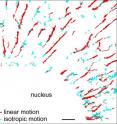The connection between a cell's cytoskeleton and its surface receptors
New findings from researchers at Harvard Medical School in Boston and the Hospital for Sick Children in Toronto may shed light on the mechanisms that regulate the organization of receptors on the cell surface, a critical aspect of cell signaling not well understood at this time. The group reports on their use of the macrophage protein CD36, a clustering-responsive class B scavenger receptor, as a model for studying the processes governing receptor clustering and organization. The protein is involved in a number of cellular and physiological functions that range from lipid metabolism to immunity, but it is unknown how the CD36 protein is organized in the cell (as monomers or as oligomers) and how that organization leads to its biological functions.
The researchers employed a combination of powerful tools: quantitative live-cell single-molecule imaging and biochemical/pharmacological approaches to study the dynamics, oligomerization and signaling of CD36 in primary human macrophages.
The group reports that movement of CD36 in the macrophage plasma membrane is regulated by the sub-membranous actin meshwork and by microtubules, demonstrating that these cytoskeletal components might play a critical role in receptor function, in general.
In terms of the impact of this research, lead researcher Khuloud Jaqaman says: "In the long run, establishing the relationship between receptor organization and cell signaling might aid in the development of drugs since receptors on the cell surface are the most accessible to pharmacological manipulation."
Source: American Institute of Physics
Other sources
- The connection between a cell's cytoskeleton and its surface receptorsfrom Science DailySun, 6 Mar 2011, 21:31:22 UTC
- The connection between a cell's cytoskeleton and its surface receptorsfrom PhysorgSun, 6 Mar 2011, 18:30:19 UTC
- The connection between a cell’s cytoskeleton and its surface receptorsfrom Science BlogSun, 6 Mar 2011, 17:30:59 UTC
- The Connection Between a Cell's Cytoskeleton and Its Surface Receptorsfrom Newswise - ScinewsSun, 6 Mar 2011, 17:30:44 UTC
